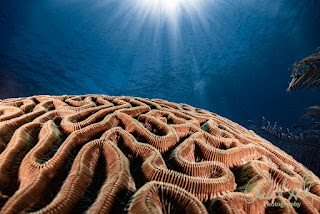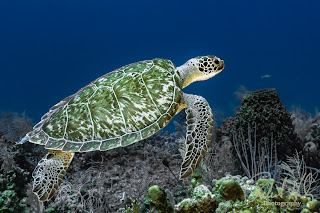Virtual Reality and Underwater Photography: The Next Frontier
How VR is revolutionizing underwater photography by creating immersive experiences.
I recently had an interesting discussion with a couple of photographers who are either in the process of using VR for underwater photography or are already using it. During one of my interviews, I had the opportunity to experience a VR dive and was truly amazed by the experience. Below is a summary of what I learned from my interviews. I have to clarify that I am not currently using VR for my work, so this information is second-hand but still very interesting.
The field of underwater photography is rapidly evolving, and one of the most exciting advancements on the horizon is the integration of Virtual Reality (VR). This technology isn't just about creating immersive experiences for viewers; it's also transforming the way we capture, process, and share underwater images. In this post, I will explore how VR is changing underwater photography, the necessary equipment, and the techniques required to explore this new frontier.
The Appeal of VR in Underwater Photography
Virtual Reality technology enables photographers to craft captivating and immersive experiences that whisk viewers into the depths of the ocean, providing a complete 360-degree perspective of marine habitats. The immersive nature of this technology can transport viewers into the underwater realm, giving them the sensation of diving alongside the photographer and immersing them in the vivid colors, graceful movements, and serene atmosphere of the undersea world. This powerful tool not only serves to captivate audiences but also holds immense potential for conservation efforts, allowing for the vivid portrayal of marine life and ecosystems, even in remote or inaccessible locations, thereby fostering a profound and immediate connection with the marine environment.
Some of the Equipment Required for VR Underwater Photography
To get started with VR underwater photography, you'll need
specialized equipment that can capture the full 360-degree environment:
- 360-Degree
Cameras:
- Insta360
ONE X3 and GoPro MAX are popular choices. These cameras are
designed to capture high-resolution, 360-degree video and photos, making
them ideal for VR content.
- For
professionals, consider using a rig with multiple GoPros or specialized
cameras like the Insta360 Titan, which offers 11K resolution.
- Underwater
Housings:
- Ensure
your 360-degree camera is protected with a waterproof housing. Companies
like AquaTech and Ikelite offer housings that are
specifically designed for 360 cameras, ensuring full functionality
underwater.
- Stabilization
Gear:
- Smooth
footage is crucial for VR. Use stabilizers like the Gimbal for 360
Cameras or floating tripods to minimize shake and achieve
professional-quality video.
- Lighting:
- Natural
light can be limited underwater, so powerful, wide-angle lights like the SeaLife
Sea Dragon 5000F are essential. These lights help to evenly
illuminate the entire 360-degree scene, ensuring no part of your VR
footage is underexposed.
Shooting Techniques
Shooting at 360 degrees underwater requires a different
approach than traditional photography. Here are some tips:
- Plan
Your Shots: With 360-degree photography, every angle is visible, so
plan your shots to ensure there’s no distracting equipment or elements in
the frame.
- Control
Buoyancy: Stable, controlled movements are essential to prevent
disorienting the viewer. Master your buoyancy to glide smoothly through
the water.
- Capture
the Entire Scene: Think beyond the subject. Include the surrounding
environment, like coral reefs, fish schools, or the play of light through
the water, to create a fully immersive experience.
Post-Processing VR Content
Editing 360-degree content requires specialized software and
techniques:
- Stitching
Software:
- Use
software like Adobe Premiere Pro VR Plugin or Insta360 Studio
to stitch together footage from multiple cameras seamlessly.
- Color
Correction and Grading:
- Underwater
environments can often skew colors. Use tools like Adobe Lightroom
and Final Cut Pro to correct color imbalances, ensuring that the
blues, greens, and other tones accurately reflect the underwater world.
- Exporting
for VR Platforms:
- Once
edited, export your footage in a format compatible with VR platforms like
Oculus or YouTube VR. Ensure that your video resolution and
frame rate meet the platform's requirements for the best viewing
experience.
Sharing and Viewing VR Underwater Content
The final step is sharing your VR content with the world.
Platforms like YouTube VR, VeeR, and Oculus allow you to
upload and showcase your work. These platforms provide viewers with the ability
to experience your dives in full 360 degrees, either through VR headsets or on
their mobile devices.
As VR technology continues to advance, it’s opening up new possibilities for underwater photographers. Whether you're looking to create immersive experiences for viewers or simply explore a new way of capturing the underwater world, VR represents a cutting-edge frontier in underwater photography. With the right equipment and techniques, you can lead your audience into the depths of the ocean like never before.
Stay Connected
Follow my blog for more tips and tutorials on underwater photography. Let's dive deeper into the art and craft of capturing the marine world!
Subscribe to my blog for more tips and tutorials on underwater photography. Don’t forget to share your processed photos on social media using the hashtag #RobertHerbPhotography. I look forward to reviewing your results.
New Online Training Program
I am excited to announce that I am creating an online training program to teach underwater hobbyists and enthusiasts how to enhance their photos using Adobe Lightroom. If you are interested in this training or more information, please contact me at bob@robertherb.com to express your interest and to be notified about the details and start date of the classes.
Stay tuned and "Follow" for upcoming blogs on underwater photography tips and tricks for more in-depth insights. Please leave your comments and suggestions. Enjoy your diving and shooting experience!
I am eagerly anticipating your valuable feedback and suggestions.
Sincerely,
Bob Herb
|
|





Comments
Post a Comment
Please let me know your comments.